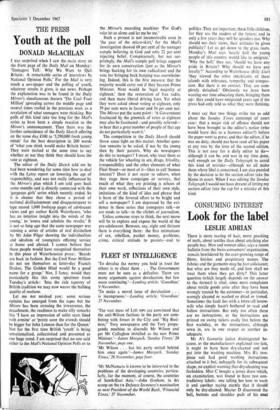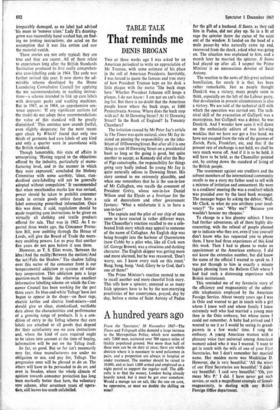Look for the label
CONSUMING INTEREST LESLIE ADRIAN
There is more tearing of hair, more gnashing of teeth, about textiles than about anything else people buy. Men and women alike, says a recent bulletin from the Swiss consumers' organisation, remain bewildered by the ever-growing range of fibres, finishes and proprietary names. The fabrics and the garments may be fort seduisants; but what are they made of, and how shall we treat them when they get dirty? This latter question (which largely depends on the answer to the former) is vital, since most complaints about textile goods arise after they have been wrongly treated by the customer—in particular, wrongly cleaned or washed or dried or ironed. Sometimes the fault lies with a know-all house- wife who simply hasn't bothered to read and follow instructions. But only too often there are no instructions, or the instructions are printed on swing tickets easily lost before the first washday, or the instructions, although sewn in, are in one respect or another in- adequate.
Mr A's favourite jacket disintegrated be- cause, as the manufacturers explained too late, it ought to have been dry-cleaned and not put into the washing machine. Mrs B's two- piece suit had good washing instructions attached to it but, unhappily for its subsequent shape, no explicit warning that dry-cleaning was forbidden. Miss C bought a jersey dress which, on examination, was found to have two con- tradictory labels: one telling her how to wash it and another saying sternly that it should only be dry-cleaned. Master D discovered the belt, buttons and shoulder pads of his coat
irreparably damaged, as no label had advised 'his mum to 'remove trims.' Lady E's dressing- gown was successfuly hand washed but, on find- ing no ironing instructions, she acted on the assumption that it was like cotton and saw the material vanish.
These stories are not only typical; they are true and they are recent. All of them relate to experiences long after the British Standards Institution produced its first really comprehen- sive care-labelling code in 1964. The code was further revised this year. It now shows the ad- mirable scheme developed by the Home Laundering Consultative Council for applying the BSI recommendations to washing instruc- tions—a scheme intended to link up care labels with detergent packs and washing machines. But in 1967, as in 1964, an apprehensive sen- tence appears: 'If any significant sections (of the trade) do not adopt these recommendations the value of this standard will be greatly diminished.' This sentence now sounds fretful, even slightly desperate; for the most recent spot check by Which? found that only two thirds of garments had care labels of any kind and only a quarter were in accordance with the British standard.
Though lamentable, this state of affairs is unsurprising. 'Having regard to the objections offered by the industry, particularly at manu- facturing level, and to the manner in which they were expressed,' concluded the Molony Committee with some acerbity, 'clear, stan- dardised care-labelling will not be generally adopted without compulsion.' It recommended that when merchandise marks law was revised, power should be taken to prohibit consumer trade in certain goods unless these bore a label conveying prescribed information. Once this was done, it said, regulations should be made requiring care instructions to be given on virtually all clothing and textile products offered for sale. That was in 1962. As I re- ported three weeks ago, the Consumer Protec- tion Bill, now ambling through the House of Lords, will give the Board of Trade the neces- sary enabling powers. Let us pray that another five years do not pass before it uses them.
However, as T. S. Eliot wrote, 'Between the idea/And the reality/Between the motion/And the act/Falls the Shadow.' The shadow falling over this sector of the consumer front is our temperamental addiction to systems of volun- tary cooperation. This addiction puts a large question-mark beside the otherwise excellent informative labelling scheme on which the Con- sumer Council has been working for the past three years. Its blue-and-white `Teltags' have just begun to appear in the shops—on floor rugs, electric kettles and electric food-mixers—and should give us clear, standardised, verifiable data about the characteristics and performance of a growing range of products. It is a con- dition of entry to the Teltag scheme that care labels are attached to all goods that depend for their satisfactory use on care instructions and, where the kind of care required ought to be taken into account at the time of buying, information will be put on the Teltag itself.
So far, so good. But so far isn't necessarily very far, since manufacturers are under no obligation to use, and pay for, Teltags. The progressive ones will be pleased to do so. The others will have to be persuaded to do so; and even in Sweden, where the whole climate of opinion towards consumer protection has long been markedly better than here, the voluntary VDN scheme, after seventeen years of opera- tion, still leaves too much unlabelled.



































 Previous page
Previous page